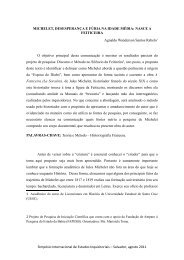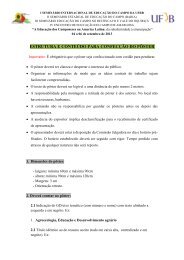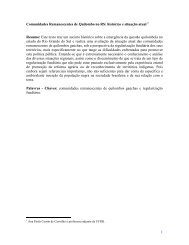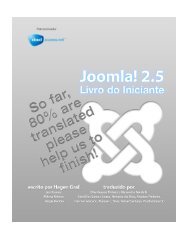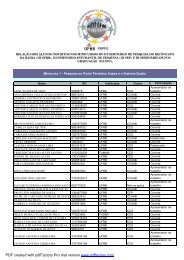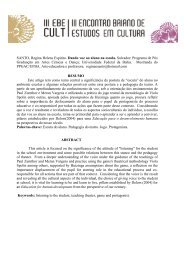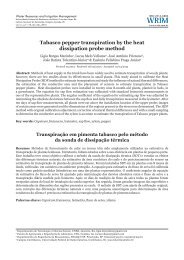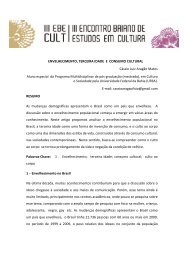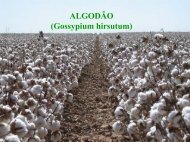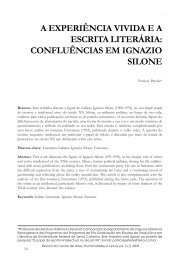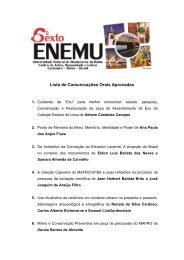Sensor placement for irrigation scheduling in banana using ... - UFRB
Sensor placement for irrigation scheduling in banana using ... - UFRB
Sensor placement for irrigation scheduling in banana using ... - UFRB
You also want an ePaper? Increase the reach of your titles
YUMPU automatically turns print PDFs into web optimized ePapers that Google loves.
<strong>Sensor</strong> <strong>placement</strong> <strong>for</strong> <strong>irrigation</strong> <strong>schedul<strong>in</strong>g</strong> <strong>in</strong> <strong>banana</strong> us<strong>in</strong>g micro-spr<strong>in</strong>kler system 21In treatment T3, the mean soil water availableat 0.2 m was 57%, where there was also 8.17%of the total water extraction. The water contentwas 60.67%, with 24.42% of the total extractionof water at the distance of 0.8 m. These resultsemphasize the ones found by other authors (Zhanget al., 1996; Elmaloglou & Diamantopoulos, 2009;Hutton & Loveys, 2011) <strong>in</strong> which, the <strong>irrigation</strong>system affected the zones of water extraction by theplant. Star<strong>in</strong>g from the pseudostem of the plants,effective water extraction distance of up to 0.7,0.8 and 0.9 m was obta<strong>in</strong>ed <strong>for</strong> a microspr<strong>in</strong>klerof 32 L h -1 <strong>for</strong> four plants, a microspr<strong>in</strong>kler of 60L h -1 <strong>for</strong> four plants and also a microspr<strong>in</strong>klerof 60 L h -1 <strong>for</strong> two plants, respectively. Effectivewater extraction depth observed was 0.25 m <strong>for</strong>all systems (Figure 7).A. T1 - 32 L h -1 <strong>for</strong> four plants<strong>Sensor</strong> <strong>placement</strong>Water sensors can be <strong>in</strong>stalled <strong>in</strong> the soil regionwhich covers distances between 0.1 and 0.7 m,and can be <strong>in</strong>stalled to a depth of 0.25 m <strong>in</strong> systemT1 (Figure 8A). In case of system T2, sensors canbe <strong>in</strong>stalled up to a distance of 0.8 m from thepseudostem of the plant, with the maximum depthbe<strong>in</strong>g 0.25 m (Figure 8B). In the case of systemT3, sensors may be located at a distance of 0.4m up to a distance of 0.9 m, with the maximumdepth be<strong>in</strong>g 0.25 m (Figure 8C).With the use of tensiometers, due to the fact thatthis technique is limited to a tension of 80 kPa, the<strong>in</strong>stallation region was reduced to the locations,where potentials observed were above -80 kPabe<strong>for</strong>e the start of <strong>irrigation</strong>. The suitable location<strong>for</strong> <strong>in</strong>stallation of tensiometers <strong>for</strong> treatment T1A. T1 - 32 L h -1 <strong>for</strong> four plants00.20.40.60.8B. T2 - 60 L h -1 <strong>for</strong> four plants1.0B. T2 - 60 L h -1 <strong>for</strong> four plantsTotal water extraction (%)Depth (m)00.20.40.60.8C. T3 - 60 L h -1 <strong>for</strong> two plants1.0C. T3 - 60 L h -1 <strong>for</strong> two plants00.20.40.60.8Distance from plant (m)Figure 7. Percentages of accumulated water extraction,by distance and depth, <strong>for</strong> T1 (A), T2 (B), T3 (C)1.00 0.2 0.4 0.6 0.8 1.0Distance from plant (m)Figure 8. Suitable region <strong>for</strong> the location of water sensors<strong>in</strong> the soil (limited <strong>in</strong> blue) <strong>for</strong> the treatments: T1(A), T2 (B) and T3 (C)Water Resources and Irrigation Management, v.1, n.1, p.15-23, 2012.



